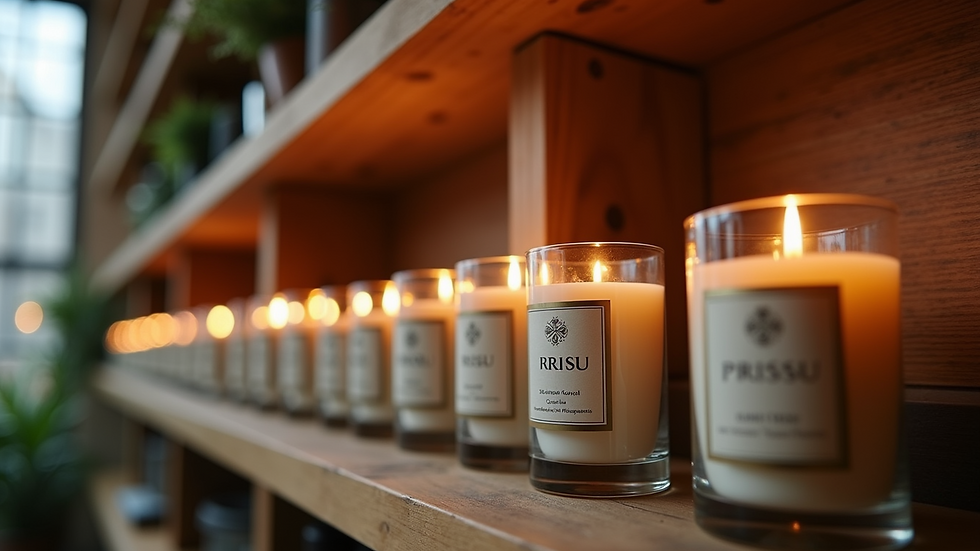Exploring the Unique Scents and Stories of Irish Candles
- mokhuisleirishcand
- 3 days ago
- 4 min read
Candles have long been a source of warmth, light, and comfort in homes around the world. In Ireland, candles carry a special significance, blending rich cultural heritage with natural beauty. Irish candles are not just about illumination; they tell stories through their unique scents and craftsmanship. This article explores the fascinating world of Irish candles, highlighting what makes them stand out and how they can transform your living space.
The Charm of Unique Irish Candles
Irish candles are renowned for their distinctive qualities that set them apart from ordinary candles. These candles often incorporate natural ingredients sourced from Ireland’s lush landscapes, such as wildflowers, peat, and native herbs. The scents evoke memories of the Irish countryside, coastal breezes, and ancient forests.
What makes these candles truly unique is the blend of tradition and innovation. Many Irish candle makers use traditional methods passed down through generations, combined with modern techniques to create long-lasting, clean-burning candles. The result is a product that not only smells wonderful but also burns evenly and safely.
Key Features of Irish Candles:
Natural ingredients: Beeswax, soy, and essential oils from native plants.
Hand-poured craftsmanship: Each candle is carefully made by artisans.
Distinctive scents: Inspired by Irish nature and folklore.
Eco-friendly packaging: Many brands use recyclable or biodegradable materials.
These features make Irish candles a perfect gift or a special treat for your own home.

Exploring Popular Scents in Irish Candles
The scent of a candle can transport you to another place and time. Irish candles are famous for their evocative fragrances that capture the essence of Ireland’s landscapes and traditions. Here are some popular scents you might find:
1. Peat and Moss
This scent reflects the earthy aroma of Ireland’s peat bogs and moss-covered forests. It’s a deep, smoky fragrance that brings a sense of grounding and calm.
2. Wild Heather and Lavender
Heather is a common sight in the Irish countryside, and its sweet, floral scent is often combined with soothing lavender to create a relaxing atmosphere.
3. Sea Salt and Ocean Breeze
Inspired by Ireland’s rugged coastline, this fresh and invigorating scent mimics the salty air and crashing waves, perfect for refreshing any room.
4. Irish Whiskey and Oak
For those who enjoy richer aromas, candles infused with notes of aged whiskey and oak barrels offer a warm, inviting scent reminiscent of traditional Irish pubs.
5. Apple Orchard and Cinnamon
This scent combines the crispness of Irish apples with the spicy warmth of cinnamon, evoking memories of autumn harvests and festive gatherings.
These scents are carefully blended to ensure they are not overpowering but provide a subtle, lasting fragrance that enhances your home environment.

How to Choose the Perfect Irish Candle for Your Space
Selecting the right candle can enhance your mood and complement your home décor. Here are some practical tips to help you choose the perfect Irish candle:
Consider the Room Size
For small rooms, opt for candles with lighter scents like wild heather or sea salt.
Larger spaces can handle stronger fragrances such as peat and whiskey.
Match the Mood
Use calming scents like lavender for bedrooms or relaxation areas.
Energizing scents like ocean breeze work well in kitchens or living rooms.
Think About Burn Time
Larger candles with longer burn times are ideal for frequent use.
Smaller candles are great for occasional ambiance or travel.
Check the Ingredients
Choose candles made from natural waxes like soy or beeswax for a cleaner burn.
Avoid candles with synthetic fragrances if you have sensitivities.
Support Local Artisans
Buying from Irish candle makers supports local businesses and ensures authenticity.
Look for brands that emphasize sustainable practices.
If you want to explore a curated selection of authentic Irish candles, consider visiting mokhuisle, a trusted source for unique Irish home fragrances.
The Stories Behind Irish Candle Making Traditions
Irish candle making is steeped in history and folklore. Traditionally, candles were essential for lighting homes during long, dark winters. Over time, candle making evolved into an art form, with each region developing its own styles and scents.
Historical Significance
Candles were used in religious ceremonies and festivals.
They symbolized hope, protection, and remembrance.
Craftsmanship and Techniques
Early candles were made from tallow, later replaced by beeswax for a cleaner burn.
Hand-dipping and hand-pouring methods are still valued for their quality.
Folklore and Symbolism
Certain scents were believed to ward off evil spirits or bring good luck.
Candles played a role in storytelling and celebrations.
Today, many Irish candle makers honor these traditions by incorporating local stories and symbols into their products. This connection to heritage adds depth and meaning to each candle.
Tips for Caring for Your Irish Candles
To get the most out of your Irish candles, proper care is essential. Here are some simple tips to ensure a safe and enjoyable experience:
Trim the wick to about 5mm before each use to prevent soot and uneven burning.
Burn the candle long enough for the wax to melt evenly across the surface to avoid tunneling.
Keep candles away from drafts to maintain a steady flame.
Never leave a burning candle unattended and keep it out of reach of children and pets.
Store candles in a cool, dry place to preserve their scent and shape.
By following these guidelines, your Irish candles will provide beautiful light and fragrance for many hours.
Irish candles offer more than just light; they bring a piece of Ireland’s natural beauty and rich culture into your home. Whether you prefer the earthy scent of peat or the fresh aroma of ocean breeze, these unique candles create an inviting atmosphere that soothes the soul. Explore the world of Irish candles and discover the stories and scents that make them truly special.




Comments